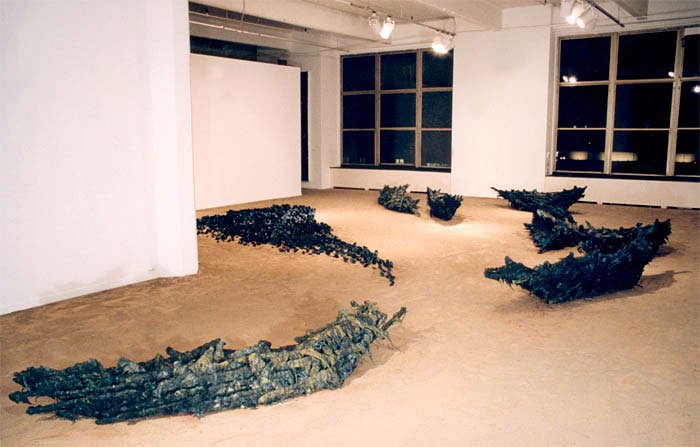Dema 1992
Prince Takamado Gallery, Embassy of Canada to Japan, Tokyo — Trois Points Gallery, Montreal, Quebec, Canada — Large boats : metallic and wood structures covered with shredded denim — L. 120 to 160 cm — Small boats : pigmented stone powder on tarlatan — L. 3 to 35 cm. “ ”
(…) “Her work is occupying a large space which looks like a ship wreck and a number of little boats drifting around the space. It seems to be quietly speaking of the transitoriness of human civilization. We inevitably feel within her works the passage of eons during which a civilization attains prosperity and the densely concentrated time during which this civilization perishes and is lost from our memory. It evokes the feelings of fear, powerlessness and mystery we experience when faced with newly discovered ruins. But the artist does not simply reject past or present civilizations. She seems to integrate herself within and looks kindly at those human activities which devote time and energy to continuously constructing civilization, while knowing that they will inevitably perish. We should probably not forget that these impressions of her work are supported by cool plastic thoughts. A large space is formed of contrasting elements such as the back, which faces outwards, and the front, which embraces an inside space. It is much like a human body, or like the outer and inner parts of a boat. In the inner part are concentrated elements which make us think of debris of artificial constructions. This might be an analogy of humanity using artificial means to assure survival against the fury of nature. Many forms which remind us of small boats are placed in regular patterns in contrast to the indefinite shape of space. The reason why the accumulation of small irregular parts which do not have a clear outline gives a very clean impression as a whole, is the artist's structuring spirit. Rather, the reason why this impression is evoked in us is the fact that the work itself is tied together by her structuring spirit. We strongly sense one dominant sentiment, unified and directed by the artist, rather than the sentiments expressed by the parts, with their differing and often mutually contradictory messages.
We are happy to see that the artist's consciousness, which reminds us of a house, is enlarged to the extent that it makes us think of human activities and the perishing of a civilization.” (…)
© Katsuhiko Yokoyama 1992, Nerima Art Museum, Japan, excerpt from Dema, translated by Dr Minoru Tsunoda.








